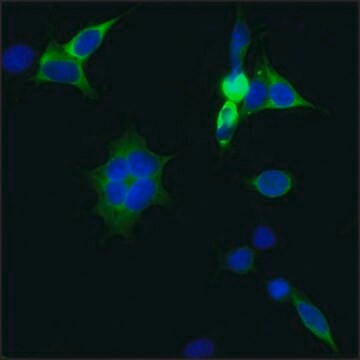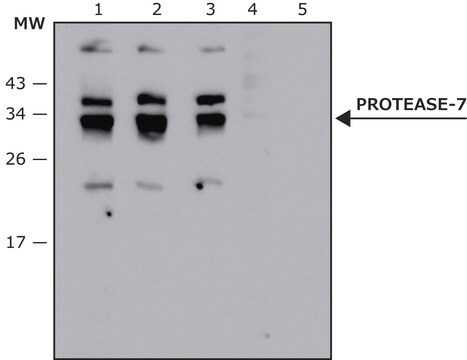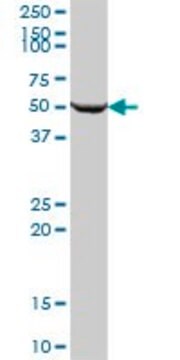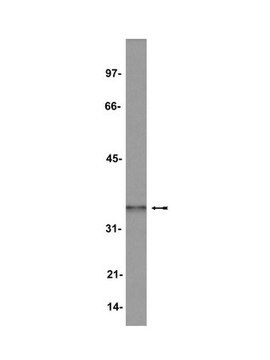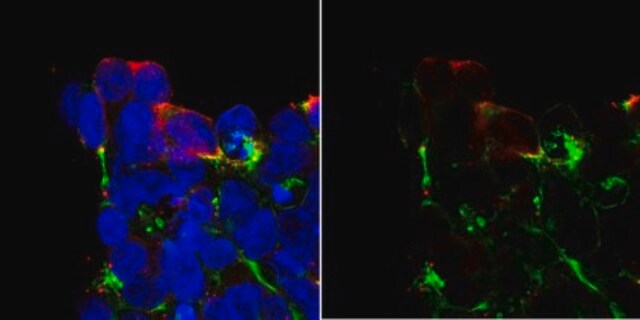SAB4200756
Anti-AsCas12a (Cpf1) antibody, Mouse monoclonal
clone AsCpf-11, purified from hybridoma cell culture
Synonyme(s) :
Anti-AsCpf1 antibody, Mouse monoclonal, Anti-CRISPR-associated endonuclease AsCas12a from Acidaminococcus sp. (strain BV3L6)
About This Item
Produits recommandés
Source biologique
mouse
Niveau de qualité
Forme d'anticorps
purified from hybridoma cell culture
Type de produit anticorps
primary antibodies
Clone
AsCpf-11, monoclonal
Forme
buffered aqueous solution
Poids mol.
~135 kDa
Concentration
~1.0 mg/mL
Technique(s)
immunoblotting: 1.25-2.5 μg/mL using purified recombinant AsCpf1 produced in E. coli
immunofluorescence: 1.25-2.5 μg/mL using human HEK-293T cells over-expressing AsCpf1 protein
immunoprecipitation (IP): 2.5-5 μg/test using lysate of human HEK-293T cells over-expressing AsCpf1 protein
Isotype
IgG2a
Numéro d'accès UniProt
Conditions d'expédition
dry ice
Température de stockage
−20°C
Modification post-traductionnelle de la cible
unmodified
Description générale
Cpf1 (CRISPR from Prevotella and Francisella 1) belongs to Class-2 type V CRISPR-Cas endonuclease system.4-5 Cpf1 comprise several differences from Cas9 protein including cleavage with 5′overhangs, a shorter guide RNA and a longer distance between the seed sequence and the cleavage site.
AsCpf1, Cpf1 from Acidaminococcus sp. (strain BV3L6), was examined together with 15 members of Cpf1 nuclease family and shown to mediate efficient genome editing in HEK293FT cells with an improved results compared to SpCas9.5 AsCpf1 crystal structure in a complex with crRNA and partially duplexed target DNA, shows that AsCpf1 acts as a monomer thus identifying a unique mechanism employed by AsCpf1 for target recognition.
Immunogène
Application
- immunoblotting (~135 kDa),
- immunofluorescence
- immunoprecipitation
Monoclonal anti-AsCpf1 antibody can provide a useful tool for genome editing research such as detecting and monitoring AsCpf1 positively transfected cells.
Forme physique
Stockage et stabilité
Autres remarques
In order to obtain best results in different techniques and preparations we recommend determining optimal working concentration by titration test.
Vous ne trouvez pas le bon produit ?
Essayez notre Outil de sélection de produits.
Code de la classe de stockage
10 - Combustible liquids
Point d'éclair (°F)
Not applicable
Point d'éclair (°C)
Not applicable
Certificats d'analyse (COA)
Recherchez un Certificats d'analyse (COA) en saisissant le numéro de lot du produit. Les numéros de lot figurent sur l'étiquette du produit après les mots "Lot" ou "Batch".
Déjà en possession de ce produit ?
Retrouvez la documentation relative aux produits que vous avez récemment achetés dans la Bibliothèque de documents.
Notre équipe de scientifiques dispose d'une expérience dans tous les secteurs de la recherche, notamment en sciences de la vie, science des matériaux, synthèse chimique, chromatographie, analyse et dans de nombreux autres domaines..
Contacter notre Service technique


